An analysis of user behavior on the NUADU platform in the past quarter has yielded interesting observations and conclusions for remote education and the process of adapting to the new reality.
In the last weeks of school closures due to the Covid-19 pandemic, tremendous changes have occurred in the area of education. Transforming the classic teaching model, in which there is daily interaction between student and teacher, into a model of remote work in such a short time turned out to be a big challenge for everyone: teachers, students, parents, and school administrators.
Since then, we’ve seen an unprecedented increase in the use of the NUADU educational platform, offering us a unique opportunity to analyze the behavior of our users. Our platform has allowed us to gather a wealth of data on remote education and the process of adapting to the safety measures of a new reality. The statistical sample was made for 50,000 students and 4,000 teachers.
1. The initiative comes from teachers
To ensure continuity of teaching, teachers had to include the existing technology in the teaching process in a very short time. While most of the online solutions have been available on the market for several years, the adoption rate has been relatively low before the pandemic.
An essential element of the process was the adaptation of tools such as:
- Digital grade book – Class or learning management systems have been used in schools for about a decade.
- E-learning platforms and knowledge evaluation tools – In recent years, they have been increasingly used in everyday work as tools to improve a teacher’s job.
- Remote communication tools – These have been available on the market for many years, but they usually do not work well in the classic school model. Given the need for social distancing, these tools are currently experiencing a surge in popularity – e.g., video-conference platforms and video-chats. Among them is the successor of Skype, the Microsoft Teams application.
Indicators of increased interest in remote education tools are statistics on the use of the NUADU application in the past three months. This covers the period when classes were still taking place in schools (February 2020), the widespread school closures due to the pandemic (March 2020), and the point when distance learning became the norm (April 2020).
1.1 Login
During the school closure period, the number of logins to the application by both teachers and students increased significantly. In March, there was a 254% increase in teacher account logins and a 213% increase for student accounts.
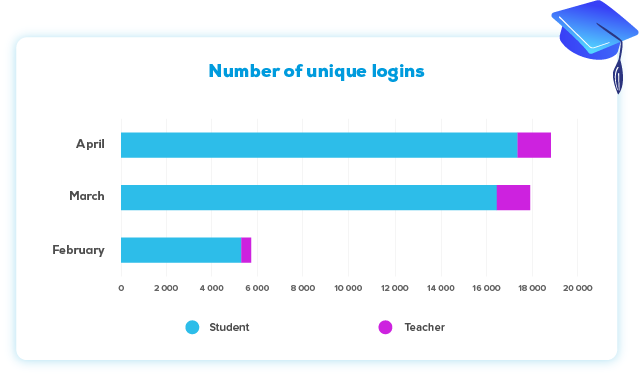
It is worth noting that the average duration of a session on the NUADU platform is close to 75 minutes for a student and over 60 minutes for a teacher. This confirms that our users find functionalities in the system that engage them and address their needs.
1.2 Assigning activities
During the school closing period, the number of activities assigned by teachers increased significantly. The term “activities” includes assignments, quizzes, and exams in the system.
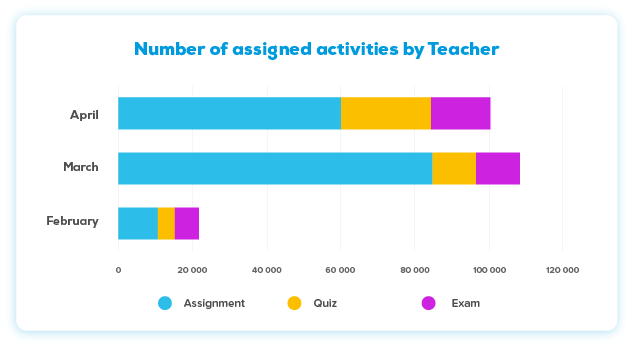
Based on the above data, we noticed a significant growth in assigned activities. We observed an increase of 486% from February to March 2020, a level that was sustained in the month of April.
1.3 Solving assignments
We also looked at the solving assignments ratio: the ratio of the number of solved activities to the number of assigned activities. This ratio was 68.5% for February, 73% for March, and 74% for April. These numbers show that students are happy to solve assigned tasks in the application, both in the classic school model (February) and the remote work model (March and April).
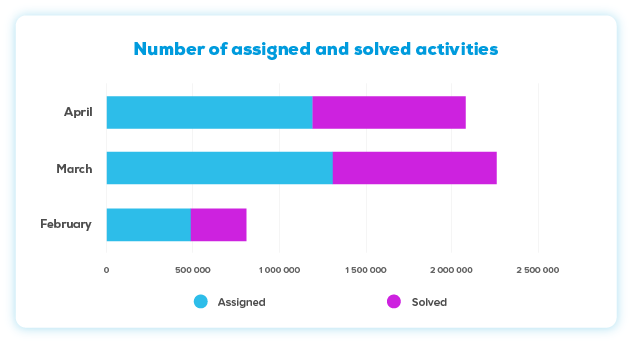
Based on the above data, it can be seen that the teacher defines how students work in the system, which directly translates into an increase in their use and interest in the NUADU application. As in the classic school model, the teacher is the main driver of the student’s work.
2. The most popular functionalities
The NUADU system, designed to improve the process of acquiring and evaluating knowledge, offers teachers several features, such as assigning and creating their tasks and automatic checking of answers. Other features include enabling individualization of the teaching process based on the collected data as well as an extensive database of interactive materials and lesson scenarios.
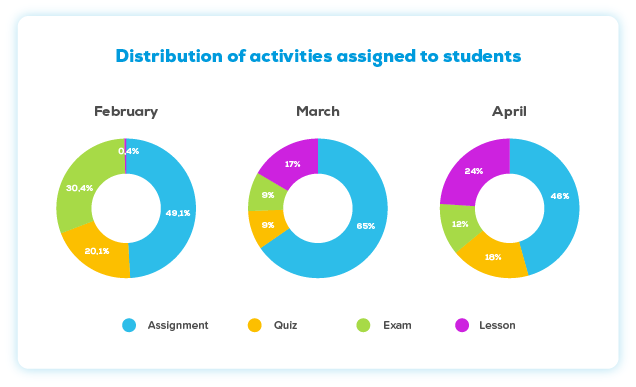
In the initial school closing period, teachers mainly used ready-made assignments, which were automatically checked by the system. With the extension of distance learning, they began to use other activities, such as quizzes and exams. However, e-lessons rarely used before this school closure got the highest interest.
3. The willingness of teachers to use remote learning tools
Teachers, especially those with extensive pedagogical experience acquired in the classic teaching model, demonstrate the need to acquire knowledge and skills related to the use of remote education tools, including the use of a computer or tablet.
This resulted in a boost in interest in the training resources conducted by NUADU, including the webinars and shared tutorials. We’ve also seen an increased use of our 24/7 chat support, which is further evidence of more teacher involvement.
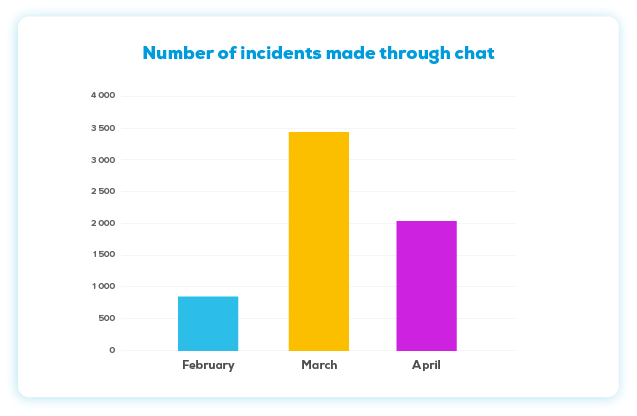
In March, the number of inquiries submitted via the NUADU support line increased four times compared to February.

4. Readiness of schools
Schools that implemented NUADU a few months or years ago show much more interest and use of the system compared to schools that are just beginning to implement the technology. In March, the number of assignments given in these schools was 40% higher than in other schools.
Overnight, the tool became the default solution and enabled the continuation of the learning process. It worth noting that all new implementations of the NUADU system in schools in March and April took place entirely remotely, including the presentation of the solution, signing of documents, configuration, and training. This proves that educational units are more open to the remote implementation process than ever.
5. Parental involvement in the teaching process
Parents currently play a leading role in the educational process of students.
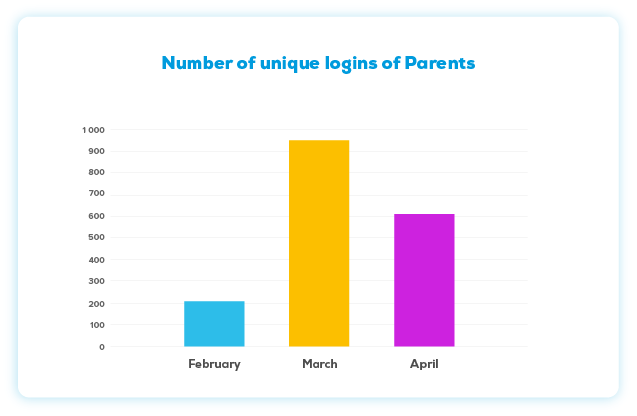
During the school closing period, we noticed a significant increase in interest in the platform among parents. This is because parents began to organize their child’s learning time, often sharing access to the same device. We recorded an increase of 349.3% in parents’ logins in March compared to February.
6. Opportunity for self-study
During the school closing period, in addition to homework set by the teachers in the activity system, the students began to use the Own Work functionality to a greater extent, which allows them to make up for deficiencies in a given area. The increase in interest reached 400% in March.
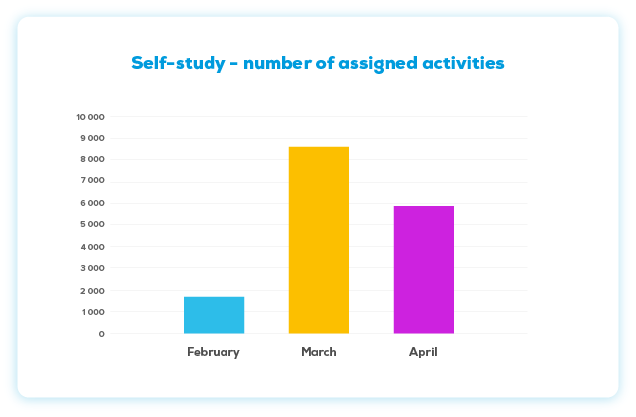

7. Summary
The beginnings of remote education, as the above conclusions show, is not as difficult as expected. The road to better education can be challenging, but the transformation has begun and will continue given the current global conditions.
With the opening of schools to the technology necessary to conduct classes remotely, the vision of supporting teachers in areas that can be served by technology becomes real. This allows them to focus on what is most important – teaching and helping students.
Currently, the NUADU platform helps teachers:
- check the tasks assigned to students,
- assess and show the individual student progress,
- suggest content that supplements student knowledge,
- save time on routine activities, and
- identify areas in which students need help.
Leveraging the benefits of technology will allow a much-needed change in the teacher’s role in the educational process from classic, a person who transfers the issues for mastery (content provider), to a more supportive role that helps students achieve their goals (facilitator)
This paradigm shift, which has been described in the world pedagogical literature for years, is highly desirable because it leads to the long-awaited evolution of the approach to educating students with continually changing needs. The digital world, specifically remote education, allows this transformation in the most straightforward and effective way.
Authors

Chief Product Officer at NUADU

Marketing Manager at NUADU
For business enquires please contact

Chief Commercial Officer at NUADU

